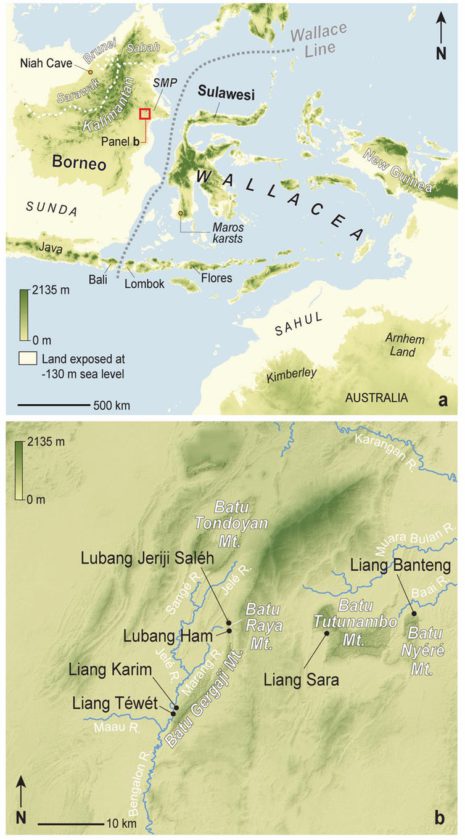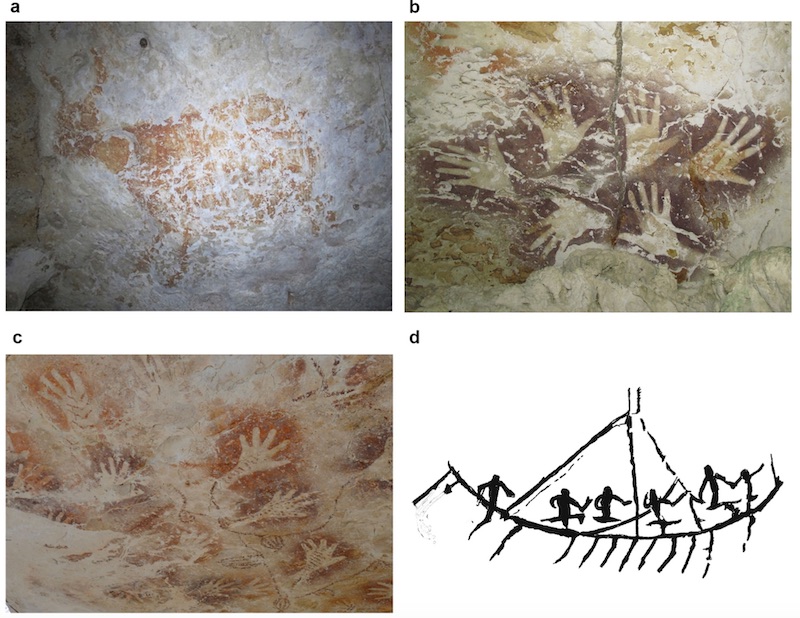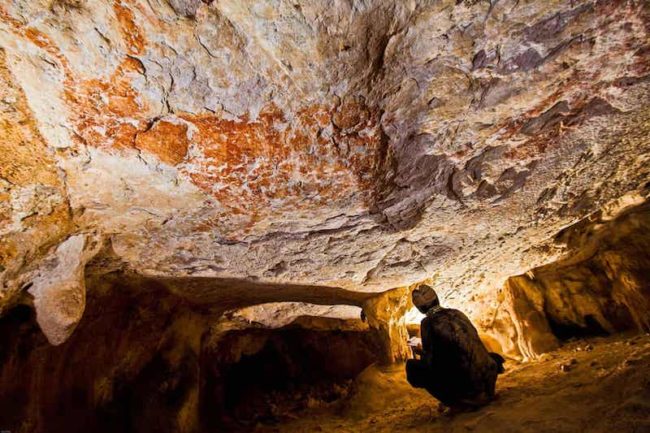
“The world’s oldest example of cave art” exclaims some of the headlines and associated media clips.
So what is this about?
Since the 1990s, caves in the remote and rugged mountains of East Kalimantan, an Indonesian province of Borneo, have been known to contain prehistoric paintings, drawings, and other imagery, including thousands of depictions of human hands (“stencils”), animals, abstract signs and symbols, and related motifs.
These near-inaccessible artworks are now known to be far older than previously thought. A study led by Griffith’s Associate Professor Maxime Aubert, along with Indonesia’s National Research Centre for Archaeology (ARKENAS), and the Bandung Institute of Technology (ITB), has been published in Nature.
It has been thought that cave art first emerged in Europe, but if this dating is correct that that is no longer the case.
The Paper In Nature
The scientific paper on it all has been published in Nature on 7th November.
Titled (strangely enough) “Palaeolithic cave art in Borneo“, it describes the details of how they used Uranium-series analysis of calcium carbonate deposits that overlie a large reddish-orange figurative painting of an animal at Lubang Jeriji Saléh—a limestone cave in East Kalimantan, Indonesian Borneo and came up with a minimum date of 40 ka.
Yes, you read that correctly … it is not 40,000 years old, but instead is at least 40,000 years old. That does indeed make it the oldest example of cave art in the world.
On that same site that have a hand stencil that has a maximum date of 51.8 ka.
Wow.
They were also able to determine that cave art has been a thing in that region over a long period of time ..
We also obtained uranium-series determinations for cave art motifs from Lubang Jeriji Saléh and three other East Kalimantan karst caves, which enable us to constrain the chronology of a distinct younger phase of Pleistocene rock art production in this region. Dark-purple hand stencils, some of which are decorated with intricate motifs, date to about 21–20 ka and a rare Pleistocene depiction of a human figure—also coloured dark purple—has a minimum date of 13.6 ka. Our findings show that cave painting appeared in eastern Borneo between 52 and 40 ka and that a new style of parietal art arose during the Last Glacial Maximum.
Can we see a bit more of it all?
Sure, here you go …
There is a Press Release associated with the paper
Available from the News section of Griffiths University we have further insights from the study authors …
“The oldest cave art image we dated is a large painting of an unidentified animal, probably a species of wild cattle still found in the jungles of Borneo – this has a minimum age of around 40,000 years and is now the earliest known figurative artwork,” Associate Professor Aubert said.
The Kalimantan stencil art was shown to be similar in age, suggesting that a Palaeolithic rock art tradition first appeared on Borneo between about 52,000 and 40,000 years ago.
Dating also indicated that a major change occurred within this culture around 20,000 years ago, giving rise to a new rock art style (including rare portrayals of humans) at a time when the global ice age climate was at its most extreme.
“Who the ice age artists of Borneo were and what happened to them is a mystery,” said team co-leader Dr Pindi Setiawan, an Indonesian archaeologist and lecturer at ITB. Setiawan has studied the art since its discovery, and, along with ARKENAS rock art expert Adhi Agus Oktaviana, leads expeditions to the Kalimantan caves.
“The new findings illustrate that the story of how cave art emerged is complex,” Oktaviana said.
Is it Really the Oldest?
We do have this insight from the study authors …
But while Borneo is the planet’s third-largest island, for most of the ice age it was connected by lower sea levels to the vast continental region of Eurasia – Borneo and Europe were opposite extremities of this landmass.
So it now seems that two early cave art provinces existed at a similar time in remote corners of Palaeolithic Eurasia: one in Indonesia, and one in Europe.
A recent study suggests Neanderthals were making rock art in Spain 65,000 years ago, but there is good reason to question this claim.
It is of course possible that the first modern human rock art arose in Africa and was introduced to Eurasia by later migrations of our species.
Alternatively, Indonesia and Europe may have been separate areas of innovation where ice age rock art emerged independently – if so, it is possible the very earliest cave paintings may one day be found in Southeast Asia rather than Europe.
Where exactly is this?
Here …
(a, top): Location of Borneo. The dated rock art is in the Sangkulirang-Mangkalihat Peninsula (SMP). (b, bottom): Rock art sites with dated cave art.
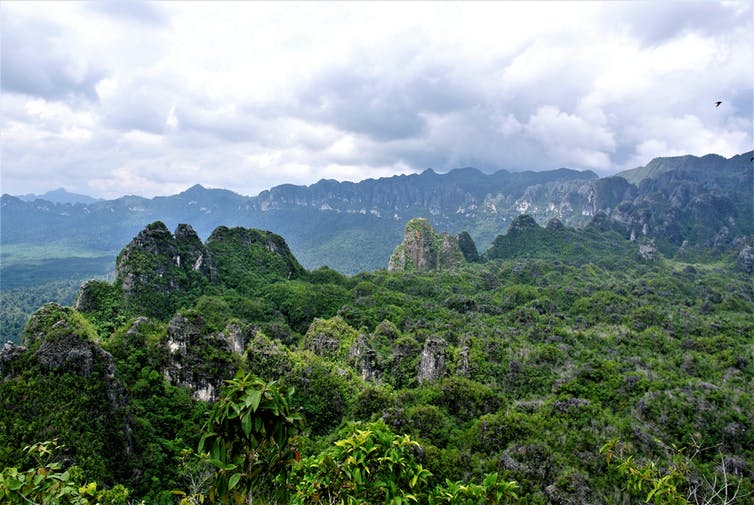
Can you show me some more examples of the cave art?
Of course …
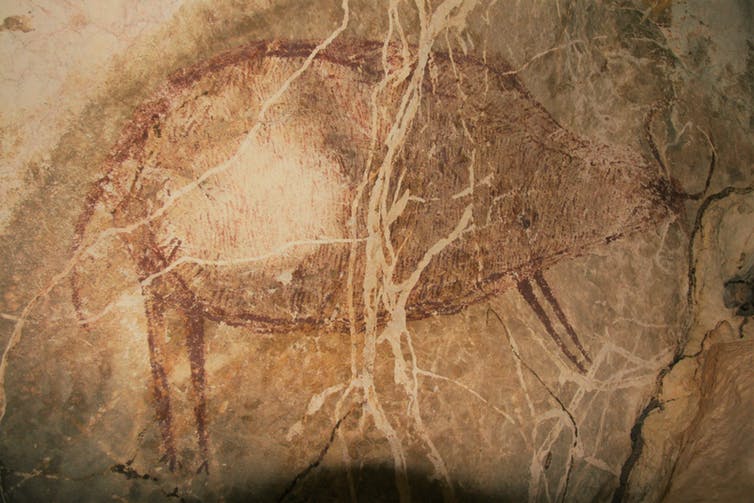
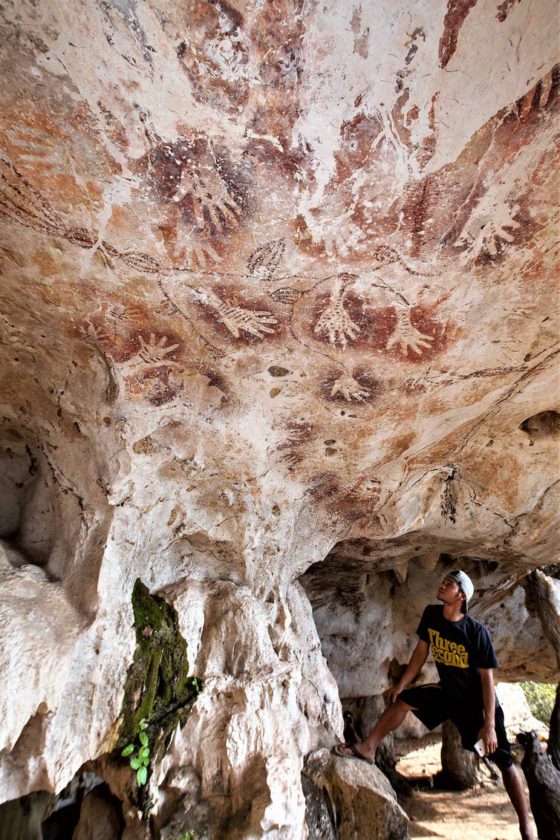
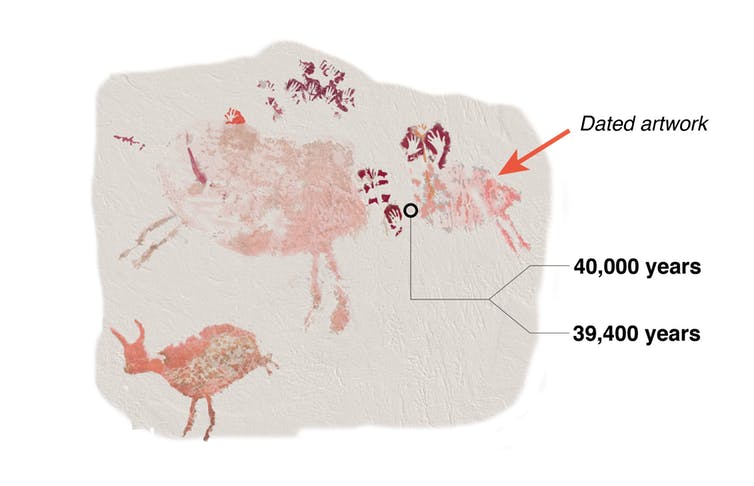
Panel a) The earliest phase of rock art production in the Sangkulirang–Mangkalihat Peninsula is associated with large, in-filled, reddish-orange-coloured paintings of animals and hand stencils.
Panel b) A second rock art phase is dominated by mulberry-coloured hand stencils— often clustered into distinct compositions and sometimes overlying hand stencils from the previous phase.
Panel c) Hand stencils from the second phase are often partly in-filled with painted designs and linked together by tree-like motifs, which possibly symbolize kinship connections. Sometimes older reddish-orange hand stencils appear to have been ‘retouched’ with mulberry-coloured paint and incorporated into these tree-like motifs.
Panel d) The later rock art phase in the Sangkulirang–Mangkalihat Peninsula is typified by anthropomorphs, boats and geometric designs that are usually executed using black pigments. This style is consistent with early Austronesian iconography, and is possibly related to the arrival of Austronesians in the region at about 4 ka, or more recently.
One Last Punchline
This may not be the oldest. It’s possible that older rock art didn’t survive the passage of time, especially if the work was scrawled on surfaces that were more exposed to the elements.
We simply don’t know, but we are not done yet.
Only about 1% of the entire cave system has been explored, so what else remains, what has yet to be discovered?
Further Reading
- National Geographic – 40,000-year-old cave art may be world’s oldest animal drawing
- The Authors of the study also wrote an article about it – Borneo cave discovery: is the world’s oldest rock art in Southeast Asia?

